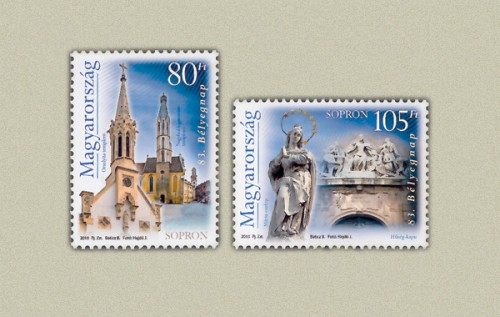
1. MAGYAR - BÉLYEGNAP 83. - Bélyeg rendelési kód: 2010 év bélyegei kompletten
2. ENGLISH - 83rd DAY OF STAMPS - Order code of the stamp: 2010 Year stamps complete
3. GERMAN - 83. TAG DER BRIEFMARKE - Die Bestellnummer Der Marke: 2010 Jahr Briefmarken komplett
Michel:
1. MAGYAR - BÉLYEGNAP 83.
A Magyar Posta hagyományai szerint két címletű bélyegsorozatot és feláras bélyegblokkot bocsát forgalomba a bélyeggyűjtők ünnepén. A 83. Bélyegnap eseményeinek – beleértve az Alpok-Adria Nemzetközi bélyegkiállítást is – 2010. március 26-28. között Sopron városa ad otthont. A bélyegnapi blokk felárából befolyó összeget – értékesített blokkonként 200 Ft-ot – a Magyar Posta a hazai szervezett bélyeggyűjtés támogatására utalja át a Magyar Bélyeggyűjtők Országos Szövetsége számára.
Sopron Magyarország nyugati határa mellett, az Alpokalján, Bécstől 60, Budapesttől 220 km-re található. A város a Soproni-hegység és a Fertő-tó melletti Balfi-dombság között, az Ikva patak völgyében fekszik. Újkőkori, réz- és bronzkori leletek tanúsága szerint a terület már az őskor óta lakott.
A római korban virágzó város állt itt, ami a népvándorlás korában romvárossá vált. Új település itt csak a honfoglalás után jött létre. A IX–XI. sz. környékén a régi városfalat kiegészítették és felépült a vár. Ekkor kapta nevét Suprun nevű ispánjáról. A vár körüli település a XIII. sz.-ban fejlődött várossá.
1277-ben IV. László király szabad királyi várossá tette. 1529-ben a törökök ugyan feldúlták a várost, ám az nem került hódoltság alá. A reformáció magyarországi terjedésének egyik központjává vált, 1557-ben már evangélikus líceum működött a városban.
1676-ban hatalmas tűzvész pusztított Sopronban, amelyben a város nagyobb része leégett. Ezt követően barokk épületeket emeltek, kialakult a mai belváros és újjáépítették a Tűztornyot is. A következő században Gróf Széchenyi István ösztönzésére megépült a Dunántúl első vasútja, amely Sopront Bécsújhellyel és Béccsel kötötte össze.
Az 1848-49-es szabadságharc után a város a Dunántúl egészére kiterjedő igazgatási hatáskörrel rendelkezett. A dualizmus korában hatalmas lendületet kapott és a millennium idején teljesedett ki. 1921-ben, a trianoni békeszerződés után népszavazás döntötte el, hogy Sopron és a környező nyolc község melyik országhoz tartozzon.
A város Magyarország mellett döntött, így azóta viseli Sopron „a leghűségesebb város” (Civitas fidelissima) címet. A város és polgársága sokat szenvedett a II. világháborúban, 1944-45-ben több légitámadás érte.
1950-ben elvesztette megyeszékhelyi rangját. Kistérségi szerepkörben először járási székhely, majd ennek megszűnte után az egykori járásától kiterjedésben nem sokkal különböző, mintegy 40 település számára a középfokú ellátás központja lett.
1991-ben megyei jogú városi rangot kapott. A város gazdag műemlékekben, látnivalókban; kulturális és zenei rendezvényei az országhatárokon kívül is ismertek. (Forrás: http://portal.sopron.hu, Dr. Tóth Imre PhD. írása)
A 80 Ft-os bélyegen a soproni Orsolyita-templom és a Nagyboldogasszony-templom, a 105 Ft-os címleten pedig a Mária-oszlop és a Hűségkapu látható. Az 500+200 Ft értékű blokk bélyegképét a Szentháromság-szobor, a keretrajzot pedig a város Fő tere díszíti. A bélyegsorhoz tartozó alkalmi boríték rajzán szintén a Fő tér, a blokkhoz tartozó borítékrajzon pedig a – Bélyegnapi rendezvényeknek otthont adó – Magyar Művelődés Házának épülete található. Az alkalmi bélyegző grafikáján a Tűztorony stilizált rajza szerepel.
Forrás: Philatelia Hungarica Kft., Magyar Posta
2. ENGLISH - 83rd DAY OF STAMPS
Following its traditions, on the special day of stamp collectors Magyar Posta is issuing a stamp series with two denominations and a miniature sheet with a surcharge.
The events of the 83rd Day of Stamps – including the Alps-Adriatic International Stamp Exhibition – will be organised in the town of Sopron between 26-28 March 2010. The amount coming in from the surcharge of the miniature sheet issued on the day of stamps – HUF 200 per sheet sold – will be transferred by Magyar Posta to the National Association of Hungarian Stamp Collectors to support national organised stamp collection.
Sopron is a town situated at the western border of Hungary, at the feet of the Alps, 60 km-s from Vienna and 220 km-s from Budapest.
The town rests between the Sopron Mountains and Balfi Hills near Fertő Lake, in the valley of Ikva stream. According to the evidence of finds from the Neolithic and the Bronze Age the area has been inhabited since prehistoric times. In the Roman age a prosperous town was standing here, which became a ruined town during the migration period.
It was only after the Hungarian Conquest when a new settlement was erected here. Around the 9-11th century the old town wall was supplemented and the castle was built. It was at this time when the town was named after its overseer called Suprun. The settlement around the castle grew into a town in the 13th century.
In 1277 King Leslie IV declared it a free royal town. Although the Turkish ravaged the town in 1529, they never occupied it. It became a centre of the propagation of reformation in Hungary, in 1557 an Evangelic school operated here. In 1676 there was an enormous outbreak of fire in Sopron, which destroyed most of the town. After the fire buildings in the Baroque style were erected, today’s inner city was established and the Fire Tower was rebuilt too.
In the following century, at the initiative of Count István Széchenyi the first railway of the Transdanubian region was built, which connected Sopron with Wiener Neustadt and Vienna. After the war of independence in 1848-1849 the town’s administrative power extended to the whole of the Transdanubian region. During the period of the dual monarchy it experienced rapid progress and accomplished itself by the millennium. In 1921, after the Treaty of Trianon it was decided by referendum which country Sopron and eight other settlements in its region wanted to belong to. The town decided to stay with Hungary, and since then it bears the title of Sopron, “the most faithful town” (Civitas fidelissima). The town and its inhabitants suffered a lot in World War II, in 1944-45 it was attacked by air-raids several times.
In 1950 it was deprived of its rank as a county town. In its small region first it became a town of district rank, and after the termination of this rank it was made into the centre of secondary services for about 40 settlements mostly forming its former district. In 1991 it was awarded the rank of a county town. The town is rich in monuments, sights; its cultural and musical events are known even beyond the country borders. (Source: http://portal.sopron.hu, an essay by Dr. Imre Tóth PhD.)
On the HUF 80 stamp the Church of Saint Ursula and Virgin Mary’s Church can be seen, while the HUF 105 denomination contains a picture of Mary’s Column and the Gates of Faith. The sheet priced HUF 500+200 is decorated with a picture of the Statue of the Holy Trinity, and the frame drawing shows the Main Square of the town.
The Main Square can be seen in the drawing of the special envelope belonging to the stamp series too, and in the envelope drawing belonging to the sheet there is the building of the House of Hungarian Culture, where the events of the Day of Stamps are organised. The illustration on the special cancellation stamp contains a stylised drawing of the Fire Tower.
3. GERMAN - 83. TAG DER BRIEFMARKE
Die Magyar Posta gibt anlässlich der Feier der Philatelisten traditionsgemäß eine aus zwei Marken bestehende Briefmarkenserie und einen Briefmarkenblock mit Aufpreis aus. Die Ereignisse des 83. Tages der Briefmarke – inklusive der internationalen ALPEN-ADRIA Briefmarkenausstellung – zwischen dem 26. und dem 28. März 2010 beherbergt die Stadt Sopron. Die Magyar Posta überweist den Betrag des Aufpreises des Blocks – 200 HUF pro verkauften Block – zur Förderung des organisierten Briefmarkensammelns in Ungarn an den Landesverein der Ungarischen Philatelisten.
Sopron ist an der Westgrenze Ungarns, am Fuße der Alpen, 60 km von Wien und 220 km von Budapest entfernt aufzufinden. Die Stadt liegt zwischen dem Soproner Gebirge und dem Hügelland von Balf am Neusiedler See, im Tal des Baches Ikva. Nach Zeugnis der Funde aus der Jungsteinzeit, Kupfer- und Bronzezeit ist das Gebiet bereits seit der Urzeit bevölkert. In der Römerzeit stand hier eine blühende Stadt, die im Zeitalter der Völkerwanderung zur Ruinenstadt wurde.
Eine neue Siedlung wurde hier erst nach der Landnahme gegründet. Vom 9. bis zum 11. Jahrhundert baute man die alten Stadtmauern aus und die Burg wurde errichtet. Zu dieser Zeit bekam sie ihren Namen von dem Gespan namens Suprun. Die am Fuße der Burg liegende Siedlung entwickelte sich im 13. Jahrhundert zur Stadt. 1277 machte sie König Ladislaus IV. zur königlichen Freistadt. 1525 wurde die Stadt zwar von den Türken verwüsteten, aber sie gelangte nie unter ihre Herrschaft.
Sie wurde zu einem der Zentren der Verbreitung der Reformation in Ungarn, 1557 war in der Stadt bereits ein evangelisches Lyzeum tätig. 1676 wütete eine riesige Feuerbrunst in Sopron, bei der ein Großteil der Stadt niederbrannte. Anschließend daran wurden Barockgebäude errichtet, es entwickelte sich die jetzige Innenstadt und auch der Feuerturm wurde wieder aufgebaut. Im darauf folgenden Jahrhundert wurde auf Initiative von Graf István Széchenyi die erste Eisenbahn Transdanubiens erbaut, die Sopron mit Wiener Neustadt und Wien verband.
Nach dem 1848-49er Freiheitskampf verfügte die Stadt über Verwaltungsbefugnisse, die sich auf ganz Transdanubien erstreckten. Im Zeitalter des Dualismus nahm sie einen raschen Aufschwung und kam zur Zeit des Millenniums zur vollen Entfaltung. 1921, nach dem Friedensvertrag von Trianon, entschied eine Volksabstimmung, zu welchem Land Sopron und die umgebenen acht Gemeinden gehören sollen.
Die Stadt entschied sich für Ungarn, so trägt Sopron seitdem den Titel „Die treueste Stadt” (Civitas fidelissima). Die Stadt und ihre Bürgerschaft litten sehr unter dem Zweiten Weltkrieg, 1944 und 1945 erlitten sie mehrere Luftangriffe. 1950 verlor die Stadt ihren Rang als Hauptort des Komitats.
Im Wirkungskreis des Kleinbezirks war sie erst Sitz des Landkreises und nach dessen Aufhebung, Versorgungszentrum mittleren Grades für etwa 40 Siedlungen, was sich von der Ausdehnung des einstigen Landkreises nicht groß unterschied. 1991 erhielt sie den Rang einer kreisfreien Stadt. Die Stadt ist reich an Denkmälern, Sehenswürdigkeiten, ihre Kultur- und Musikveranstaltungen sind auch im Ausland bekannt. (Quelle: http://portal.sopron.hu, Autor: Dr. Imre Tóth PhD)
Auf der 80-Ft-Briefmarke sind die Ursulinenkirche und die Jungfrauenkirche von Sopron und auf der 105-Ft-Briefmarke die Mariensäule und das Tor der Treue zu sehen. Das Briefmarkenbild des Blocks im Wert von 500+200 Ft ziert die Dreifaltigkeitssäule und auf der Rahmenzeichnung ist der Hauptplatz (Fő tér) der Stadt abgebildet. Auf der Zeichnung des zur Briefmarkenserie gehörenden Sonderumschlags ist ebenfalls der Hauptplatz (Fő tér) und auf der Zeichnung des zum Block gehörenden Umschlags das Gebäude des „Hauses der Ungarischen Kultur“ zu sehen, das die Veranstaltungen des Tages der Briefmarke beherbergt. Auf der Grafik des Sonderstempels ist die stilisierte Zeichnung des Feuerturms von Sopron aufzufinden.










